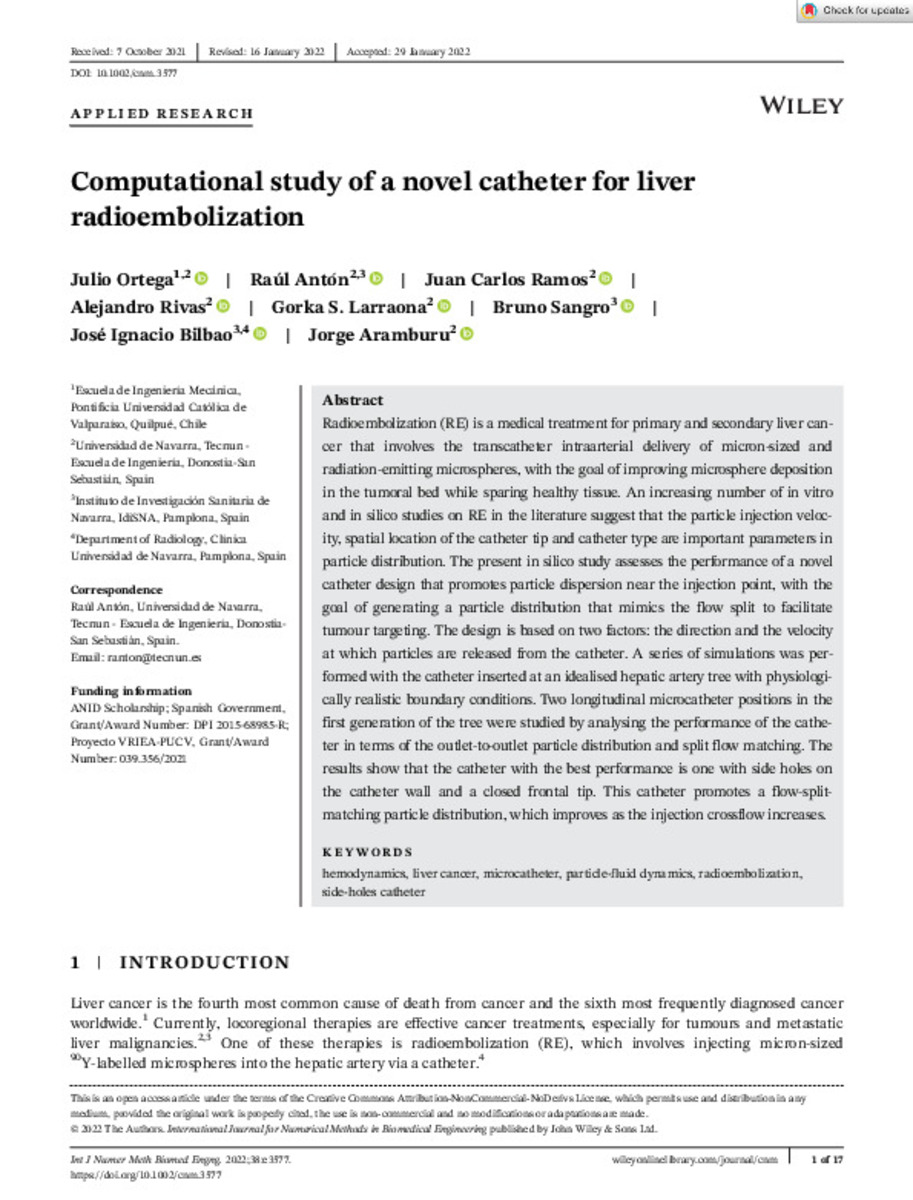Full metadata record
| DC Field | Value | Language |
|---|---|---|
| dc.creator | Ortega, J. (Julio) | - |
| dc.creator | Antón, R. (Raúl) | - |
| dc.creator | Ramos-González, J. (Juan Carlos) | - |
| dc.creator | Rivas, A. (Alejandro) | - |
| dc.creator | Sanchez-Larraona, G. (Gorka) | - |
| dc.creator | Sangro, B. (Bruno) | - |
| dc.creator | Bilbao, J.I. (José I.) | - |
| dc.creator | Aramburu-Montenegro, J. (Jorge) | - |
| dc.date.accessioned | 2022-07-01T07:28:50Z | - |
| dc.date.available | 2022-07-01T07:28:50Z | - |
| dc.date.issued | 2022 | - |
| dc.identifier.citation | Ortega, J. (Julio); Antón, R. (Raúl); Ramos, J.C. (Juan Carlos); et al. "Computational study of a novel catheter for liver radioembolization". International Journal of Numerical Methods in Biomedical Engineering. (38), 2022, e3577 | es |
| dc.identifier.issn | 2040-7947 | - |
| dc.identifier.uri | https://hdl.handle.net/10171/63759 | - |
| dc.description.abstract | Radioembolization (RE) is a medical treatment for primary and secondary liver can-cer that involves the transcatheter intraarterial delivery of micron-sized andradiation-emitting microspheres, with thegoal of improving microsphere depositionin the tumoral bed while sparing healthytissue. An increasing number of in vitroand in silico studies on RE in the literature suggest that the particle injection veloc-ity, spatial location of the catheter tip and catheter type are important parameters inparticle distribution. The present in silico study assesses the performance of a novelcatheter design that promotes particle dispersion near the injection point, with thegoal of generating a particle distribution that mimics the flow split to facilitatetumour targeting. The design is based on two factors: the direction and the velocityat which particles are released from the catheter. A series of simulations was per-formed with the catheter inserted at an idealised hepatic artery tree with physiologi-cally realistic boundary conditions. Two longitudinal microcatheter positions in thefirst generation of the tree were studied by analysing the performance of the cathe-ter in terms of the outlet-to-outlet particle distribution and split flow matching. Theresults show that the catheter with the best performance is one with side holes onthe catheter wall and a closed frontal tip. This catheter promotes a flow-split-matching particle distribution, which improves as the injection crossflow increases. | es_ES |
| dc.description.sponsorship | This research was funded by the Spanish Government through project DPI 2015-68985-R. The authors gratefullyacknowledge the support of C atedra Fundaci on Antonio Aranz abal-Universidad de Navarra and the financial supportof the first author via an ANID Scholarship (Becas Chile) and Proyecto VRIEA-PUCV 039.356/2021. | es_ES |
| dc.language.iso | eng | es_ES |
| dc.publisher | Wiley | es_ES |
| dc.rights | info:eu-repo/semantics/openAccess | es_ES |
| dc.subject | Hemodynamics | es_ES |
| dc.subject | Liver cancer | es_ES |
| dc.subject | Microcatheter | es_ES |
| dc.subject | Particle-fluid dynamics | es_ES |
| dc.subject | Radioembolization | es_ES |
| dc.subject | Side-holes catheter | es_ES |
| dc.title | Computational study of a novel catheter for liver radioembolization | es_ES |
| dc.type | info:eu-repo/semantics/article | es_ES |
| dc.description.note | This is an open access article under the terms of the Creative Commons Attribution-NonCommercial-NoDerivs License | es_ES |
| dc.identifier.doi | 10.1002/cnm.3577 | - |
| dadun.citation.number | 38 | es_ES |
| dadun.citation.publicationName | International Journal of Numerical Methods in Biomedical Engineering | es_ES |
| dadun.citation.startingPage | e3577 | es_ES |
Files in This Item:
Statistics and impact
Items in Dadun are protected by copyright, with all rights reserved, unless otherwise indicated.






